How ABA Therapy Encourages Healthy Risk Assessment Skills

Unlocking the Role of ABA in Healthy Risk Assessment
Applied Behavior Analysis (ABA) therapy is a cornerstone intervention in supporting individuals with autism spectrum disorder (ASD), focused not only on improving core skills but also on fostering essential life competencies such as healthy risk assessment. This article explores how ABA therapy empowers children and adults with autism to navigate their environments safely and confidently by understanding risks, making informed choices, and promoting independence.
Understanding Applied Behavior Analysis (ABA) Therapy and Its Foundations

What is Applied Behavior Analysis (ABA) therapy, and how does it help individuals with autism?
Applied Behavior Analysis (ABA) therapy is a scientifically validated method that analyzes, designs, implements, and evaluates environmental changes to promote meaningful behavioral improvements, particularly for individuals with autism spectrum disorder (ASD). It aims to increase helpful behaviors such as communication, social skills, and independence, while reducing harmful or challenging behaviors.
Definition and goals of ABA therapy
ABA therapy is personalized and based on behavioral principles that include positive reinforcement and the ABC model (Antecedent, Behavior, Consequence). Treatment plans are individualized, guided by patient needs, caregiver input, and ongoing assessments. Its goals focus on helping individuals develop essential life skills to participate more fully in society and enhance their quality of life.
Scientific basis and systematic approach
ABA’s effectiveness is supported by decades of empirical research, including randomized controlled trials and meta-analyses. It integrates behavioral principles systematically, ensuring interventions are data-driven with continuous supervision by qualified professionals such as Board Certified Behavior Analysts (BCBAs).
Behavioral principles applied in ABA
ABA applies behavioral principles like positive reinforcement to encourage desired behaviors, functional communication training to replace problem behaviors, and functional behavioral assessments to understand and address the reasons behind specific behaviors. Modern approaches are often naturalistic and play-based, focusing more on engagement and less on repetitive drills. Importantly, ABA respects neurodiversity and focuses on skill-building rather than eradicating inherent autistic traits.
ABA’s structured, client-centered nature and extensive research foundation have made it the leading evidence-based treatment for autism, particularly effective when begun early with high intensity.
Who Provides ABA Therapy? The Professional Team Behind Effective Interventions

Qualifications of ABA Providers
ABA therapy is provided by a team of professionals with specialized training in behavior analysis. The primary providers include Board Certified Behavior Analysts (BCBAs), Board Certified Assistant Behavior Analysts (BCaBAs), and Registered Behavior Technicians (RBTs). BCBAs hold master’s degrees in psychology, education, or related fields and must complete supervised practical experience along with passing a certification exam by the Behavior Analyst Certification Board (BACB). BCaBAs are certified at an assistant level and work under BCBA supervision. RBTs typically have some college education and complete specific training and certification to implement behavior plans directly.
Roles of BCBAs, RBTs, and BCaBAs
BCBAs design individualized ABA interventions, oversee assessment, develop treatment plans, and monitor progress. They ensure that interventions are scientifically validated and tailored to meet each child’s needs. BCaBAs assist BCBAs with assessment and intervention planning, often taking a supporting role in supervision. RBTs work closely with clients delivering daily therapy sessions under supervision, applying behavior analytic techniques such as positive reinforcement and functional communication training. This tiered service delivery enhances flexibility and allows for focused implementation of treatment goals.
Collaborative Team Approaches
ABA therapy involves collaboration among these professionals, caregivers, and other specialists. Effective communication and shared decision-making allow the team to adapt interventions dynamically to the child's progress and family input. This interdisciplinary approach may also integrate consultation with medical and psychiatric providers when complex cases involve biological factors alongside behavioral ones.
Supervision and Training Requirements
Ongoing supervision by BCBAs is essential to maintain treatment fidelity and adjust strategies based on continuous data collection. Supervisors oversee the work of RBTs and BCaBAs to ensure ethical, evidence-based practices. Training includes regular review of procedures, functional behavior assessments, and the use of validated assessment tools. This structured oversight supports quality assurance and promotes successful treatment outcomes.
Core Techniques and Methods Utilized in ABA for Autism

What are the common techniques and methods used in ABA therapy for autism?
Applied Behavior Analysis (ABA) therapy employs a variety of structured and naturalistic techniques to teach new skills and improve behavior in individuals with autism.
A foundational method is Discrete Trial Training (DTT), which breaks skills into small, manageable components taught through repeated trials with clear prompts and reinforcements. While DTT was initially more rigid, current approaches are more individualized and play-based to better engage children.
Natural Environment Teaching (NET) complements DTT by using real-life situations and the learner’s interests to promote skills generalization beyond clinical settings.
ABA also utilizes behavior chaining and modeling to teach complex sequences of actions by breaking them down or demonstrating them visually.
Techniques like prompting and fading guide learners towards independence by initially providing cues or assistance and gradually reducing them as skills improve.
Visual supports such as video modeling and social stories are powerful tools for enhancing understanding of social situations and expected behaviors.
Central to ABA is the ABC model (Antecedent-Behavior-Consequence), which systematically analyzes the triggers and outcomes of behavior to inform targeted interventions.
Positive reinforcement is the core strategy within ABA, where desired behaviors are encouraged by rewarding them, increasing the likelihood they will occur again. Extinction and redirection strategies help in decreasing problematic behaviors by withholding reinforcement or offering alternative appropriate behaviors.
All these methods are carefully individualized based on thorough assessments and ongoing data collection. Treatment plans consider the child’s age, environment, and needs, and are adjusted to ensure effectiveness across home, school, and community settings.
How ABA Therapy Develops Healthy Risk Assessment Skills in Individuals with Autism
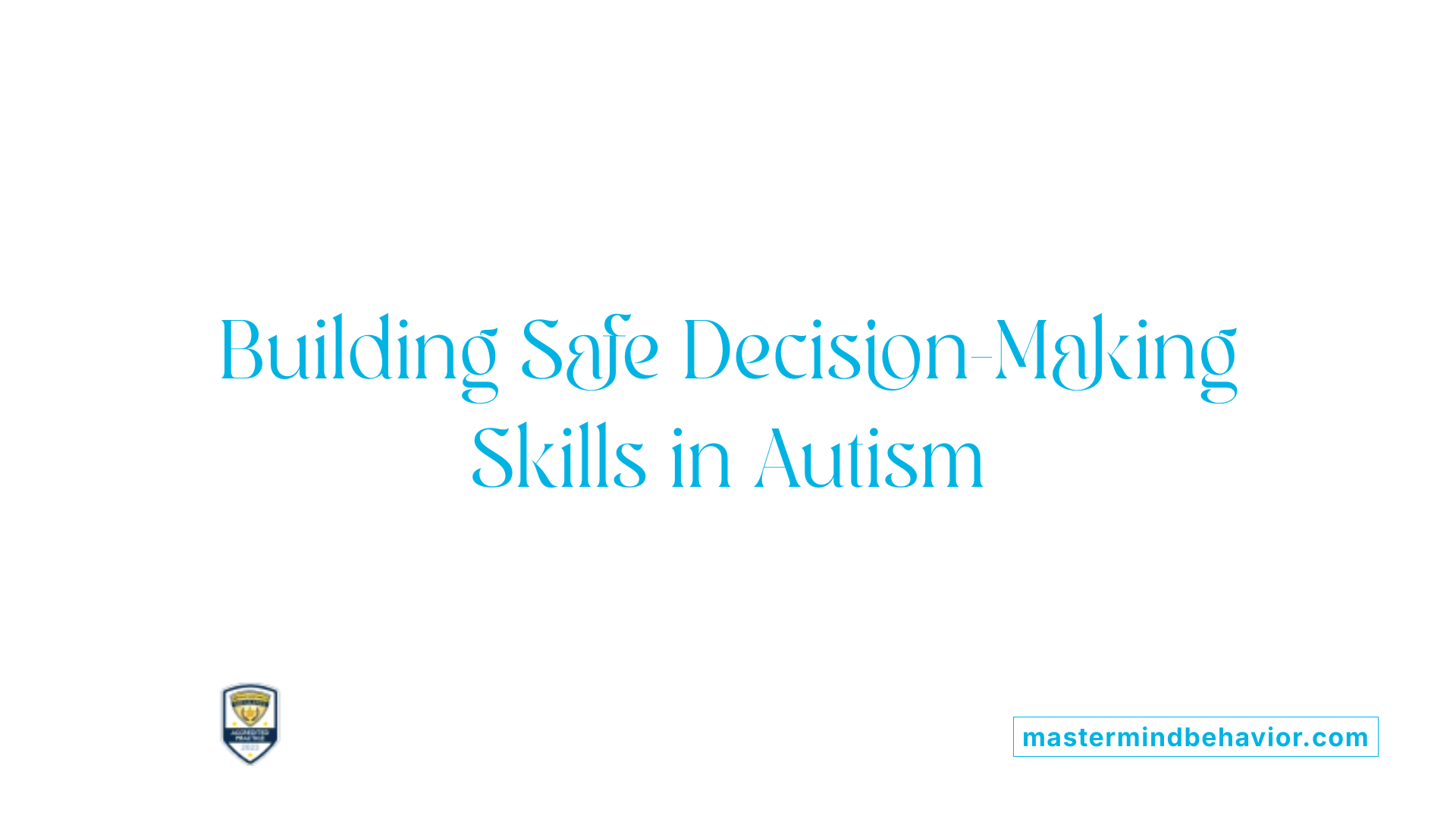
Teaching decision-making through behavioral principles
Applied Behavior Analysis (ABA) fosters decision-making skills by applying behavioral principles that encourage individuals to evaluate and act in ways that promote safety and well-being. ABA emphasizes understanding the consequences of actions and reinforcing choices that lead to positive outcomes, helping individuals with autism develop healthier risk assessment abilities.
Functional behavior assessment (FBA) and environmental analysis
ABA integrates Functional Behavior Assessment (FBA), a client-driven method that identifies environmental variables influencing problem behaviors. By analyzing the context of behaviors, practitioners can understand triggers and supports, enabling tailored interventions that guide individuals toward making safer decisions in risky situations.
Promoting appropriate risk-taking while ensuring safety
ABA strategies do not eliminate risk-taking but promote appropriate and cautious exploration. Interventions often balance encouraging independence with safety considerations, adapting based on the individual’s developmental level and environmental risks to foster growth without compromising protection.
Use of functional communication training (FCT) to support choices
Functional Communication Training (FCT) is used within ABA to teach individuals alternative, appropriate communicative behaviors as replacements for problem behaviors. FCT empowers individuals to express needs, preferences, or concerns, thereby supporting better decision-making and safer choices in situations involving risk.
Role of positive reinforcement in fostering cautious exploration
Positive reinforcement is a cornerstone of ABA that strengthens desired behaviors, including carefully considered risk-taking. By rewarding cautious exploration and successful decision-making, it encourages individuals with autism to engage with their environment thoughtfully, promoting healthy risk assessment skills over time.
Functional Behavior Assessment (FBA): The Keystone of Targeted Interventions
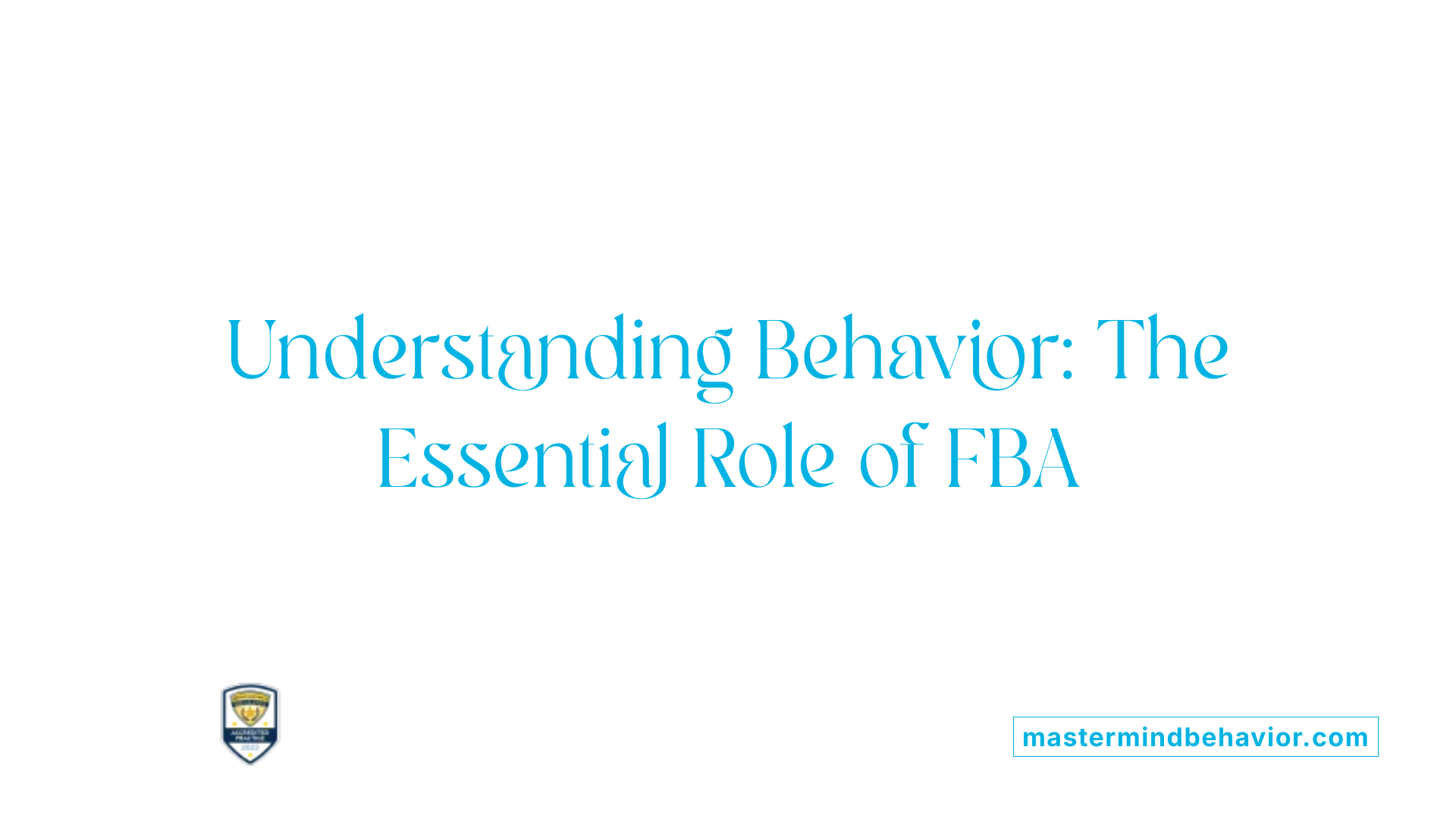
What Is the Purpose and Process of FBA?
Functional Behavior Assessment (FBA) is a client-driven method designed to identify the environmental variables controlling problem behavior, particularly in children with autism spectrum disorder (ASD) and intellectual disability (ID). It involves a systematic process including record reviews, interviews, and direct observation to gather comprehensive data on when and why specific behaviors occur.
How Does FBA Identify Environmental Variables Influencing Behavior?
Through detailed observation and analysis, FBA pinpoints triggers and consequences in the environment that maintain problematic behaviors. By understanding these factors, practitioners can uncover the function that the behavior serves for the individual, such as seeking attention or avoiding certain demands.
How Does FBA Inform Risk-Related Behavior Modification?
Knowing the function of a problem behavior allows for precise behavioral interventions like extinction, non-contingent reinforcement (NCR), differential reinforcement, and functional communication training (FCT). These strategies target the root cause of behaviors, which can lead to significant reductions in problem behaviors — sometimes over 80% decrease. Furthermore, FBA assists in risk assessment and mitigation protocols, especially relevant during the COVID-19 pandemic, where safety procedures must consider both individual and regional risk factors.
How Is FBA Integrated with Behavioral and Pharmacologic Treatments?
The insights gained from FBA extend beyond behavioral interventions. Understanding the function of a behavior can inform psychiatric and pharmacologic treatment approaches as part of an integrative transdisciplinary strategy. This combined approach is recommended for complex cases where biological and environmental factors interact to affect behavior. Thus, FBA serves as a foundational step in crafting personalized intervention plans that address multiple dimensions of a child's needs.
Enhancing Communication to Support Safer Risk Assessment

Functional communication training (FCT) to replace problem behaviors
Functional communication training (FCT) is a behaviorally based intervention that teaches individuals with autism and intellectual disabilities to use appropriate communicative behaviors as alternatives to problem behaviors. By understanding the underlying function of challenging behaviors via a functional behavior assessment, FCT replaces these behaviors with more effective and socially acceptable communication methods. This not only reduces the frequency of problem behaviors by over 80% in many cases but also promotes clearer and safer interactions in challenging environments.
Teaching individuals to express needs and safety concerns
A critical aspect of FCT involves equipping individuals with skills to express their needs, preferences, and safety concerns. This capacity enables children to alert caregivers or professionals when they experience discomfort or perceive risk, facilitating timely and appropriate interventions. By fostering these communication skills, ABA practitioners help children convey emotions and requests clearly, reducing misunderstandings that could lead to heightened risk or problem behavior.
Improving social interaction to facilitate environmental awareness
Beyond direct communication, increasing an individual’s ability to engage in positive social interactions is vital for safer risk assessment. ABA's play-based and naturalistic methods encourage children to attend to social cues and environmental changes. Enhanced social responsiveness supports better awareness of surroundings and potential hazards, contributing to safer behavior choices. When children learn to interpret and respond to social and environmental signals effectively, they can better navigate daily challenges and reduce exposure to risk.
Through these strategies, ABA-based functional communication training plays a crucial role in supporting safer risk assessment and mitigation. It empowers children with ASD and ID to communicate effectively, understand their environments, and interact positively, fostering safer and more responsive care practices.
The Role of Comprehensive ABA Interventions in Early Childhood to Promote Lifelong Safety Skills
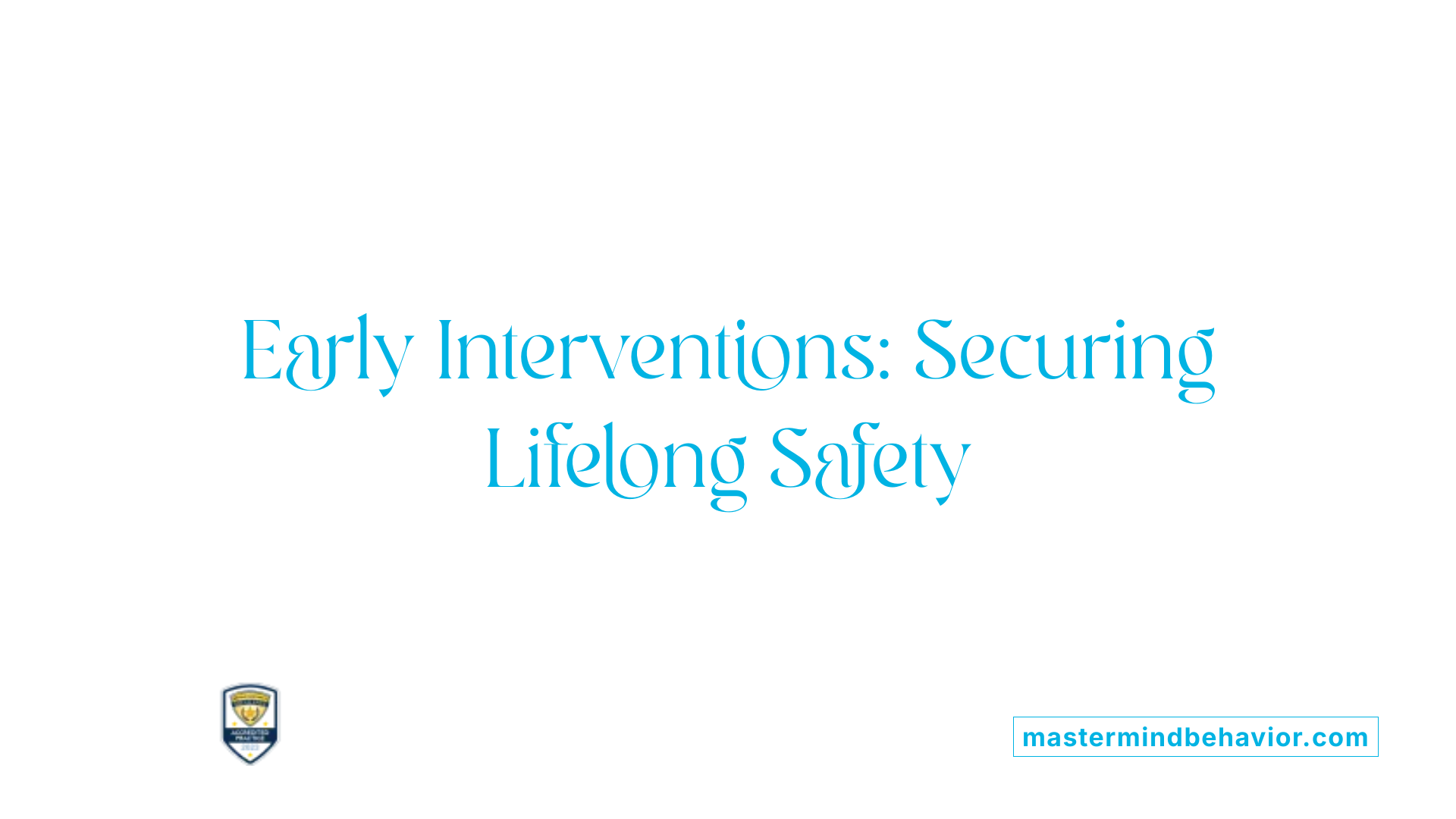
Early Intensive Behavioral Interventions (EIBI)
Early Intensive Behavioral Interventions, commonly known as EIBI, represent a foundational approach in applied behavior analysis tailored for young children with autism spectrum disorder (ASD). Implemented typically around ages 3 to 4, EIBI utilizes scientifically validated methods to help children acquire essential skills, including safety awareness. This approach is designed to be comprehensive, addressing several developmental areas concurrently to foster broad-based skill acquisition.
Personalized, High-Intensity Interventions
EIBI and other comprehensive ABA interventions are characterized by their high intensity — usually between 20 to 40 hours per week — and personalization based on the child’s individual needs. This high-dose delivery is crucial for promoting meaningful and lasting change in behavior. Treatment plans are meticulously adapted, ensuring that learning opportunities are appropriately aligned with the child's unique development and family priorities.
Focus on Multiple Skills Including Safety Awareness
These interventions do not merely target isolated behaviors; they encompass a variety of skills critical for daily functioning, including cognitive, communicative, social, and adaptive behaviors. Safety skills, such as recognizing environmental hazards, responding to dangerous situations, and effective communication about needs, are integral components. Functional communication training (FCT), a strategy often included, teaches children safe and appropriate ways to express themselves, greatly reducing problem behaviors and improving safety.
Longitudinal Benefits in Intellectual and Adaptive Functioning
Research synthesized through meta-analyses indicates that early, comprehensive ABA-based interventions have a medium effect on intellectual functioning and a small effect on adaptive behavior. While improvements in language abilities or symptom severity may be less pronounced, gains in intellectual and adaptive skills contribute to a child’s capability to navigate their environment safely over time. These interventions lay the groundwork for continued development of independence and safety awareness throughout childhood and beyond.
Together, these elements illustrate how comprehensive early ABA interventions play a critical role in building lifelong safety skills and promoting well-rounded development in young children with ASD.
Naturalistic Developmental Behavioral Interventions (NDBI) and Play-Based ABA Approaches

Use of natural settings for teaching risk assessment
Naturalistic Developmental Behavioral Interventions (NDBI), including approaches like the Early Start Denver Model (ESDM), focus heavily on teaching skills within natural settings rather than clinical or artificial environments. This approach supports learning in the child's everyday surroundings, such as home or community settings, making risk assessment skills more relevant and easier to generalize. For example, children learn how to recognize and respond to environmental hazards during typical play or daily routines, which enhances real-world safety and independence.
Incorporation of child interests and play
Play-based ABA approaches integrate child interests to boost motivation and engagement. Unlike older, more rigid ABA protocols such as Discrete Trial Training, modern methods emphasize participating in activities that the child finds enjoyable and meaningful. This individualized strategy not only enhances learning but also respects the child's preferences, fostering a positive atmosphere for skill acquisition, including vital risk recognition and mitigation behaviors.
Balancing repetition with engaging activities
While repetition remains a cornerstone of behavior analysis to help children master new skills, contemporary ABA has moved towards reducing rote drills in favor of more varied and engaging activities. This balance helps maintain attention and prevents boredom during sessions. By embedding learning opportunities within playful interactions, practitioners ensure that children acquire risk-related skills naturally and effectively without overwhelming them with monotonous tasks.
Together, these naturalistic and play-based ABA methods align with modern therapeutic goals: supporting skill building in respectful, child-centered ways while ensuring practical learning outcomes like enhanced risk assessment and safety.
ABA Therapy’s Role in Encouraging Independence and Decision-Making in Adults with Autism

How does ABA therapy benefit children and adults with autism across different developmental stages?
ABA therapy supports individuals with autism at every stage of development by fostering communication, social, and independence skills. In children, it builds foundational abilities such as language acquisition, self-care, and academic learning. It also effectively reduces challenging behaviors through personalized, evidence-based interventions like functional communication training and differential reinforcement.
For adults, ABA shifts focus to refining vocational competence, daily living skills, and socially appropriate interactions. This enables adults with autism to make safer, autonomous choices and to perform daily tasks that reduce dependence on constant supervision.
Vocational and daily living skill development
Applied Behavior Analysis programs for adults target practical skill-building to enhance employability and independent living. Interventions often include training in time management, money handling, meal preparation, and workplace social skills. These skills empower individuals to sustain meaningful employment and live more independently.
Facilitating autonomous and safe behavior choices
ABA employs functional behavior assessments to understand behavior motivations and designs interventions that promote safe decision-making. Techniques such as non-contingent reinforcement and functional communication training teach adults to replace problematic behaviors with socially acceptable, functional alternatives. This increases their ability to independently navigate complex social and safety situations.
Reducing reliance on supervision through skill acquisition
By teaching comprehensive skills tailored to personal needs, ABA therapy reduces the need for continuous caregiver oversight. Individuals learn strategies for problem solving and self-management, which foster confidence and personal agency. Supervised practice and ongoing assessment ensure that acquired skills generalize to various environments, further promoting autonomy.
In conclusion, ABA therapy, through its adaptable and individualized framework, plays a critical role in enhancing independence and decision-making in adults with autism. This promotes a higher quality of life and greater participation in community and vocational settings.
Using Data and Ongoing Assessment to Tailor Risk Assessment Interventions
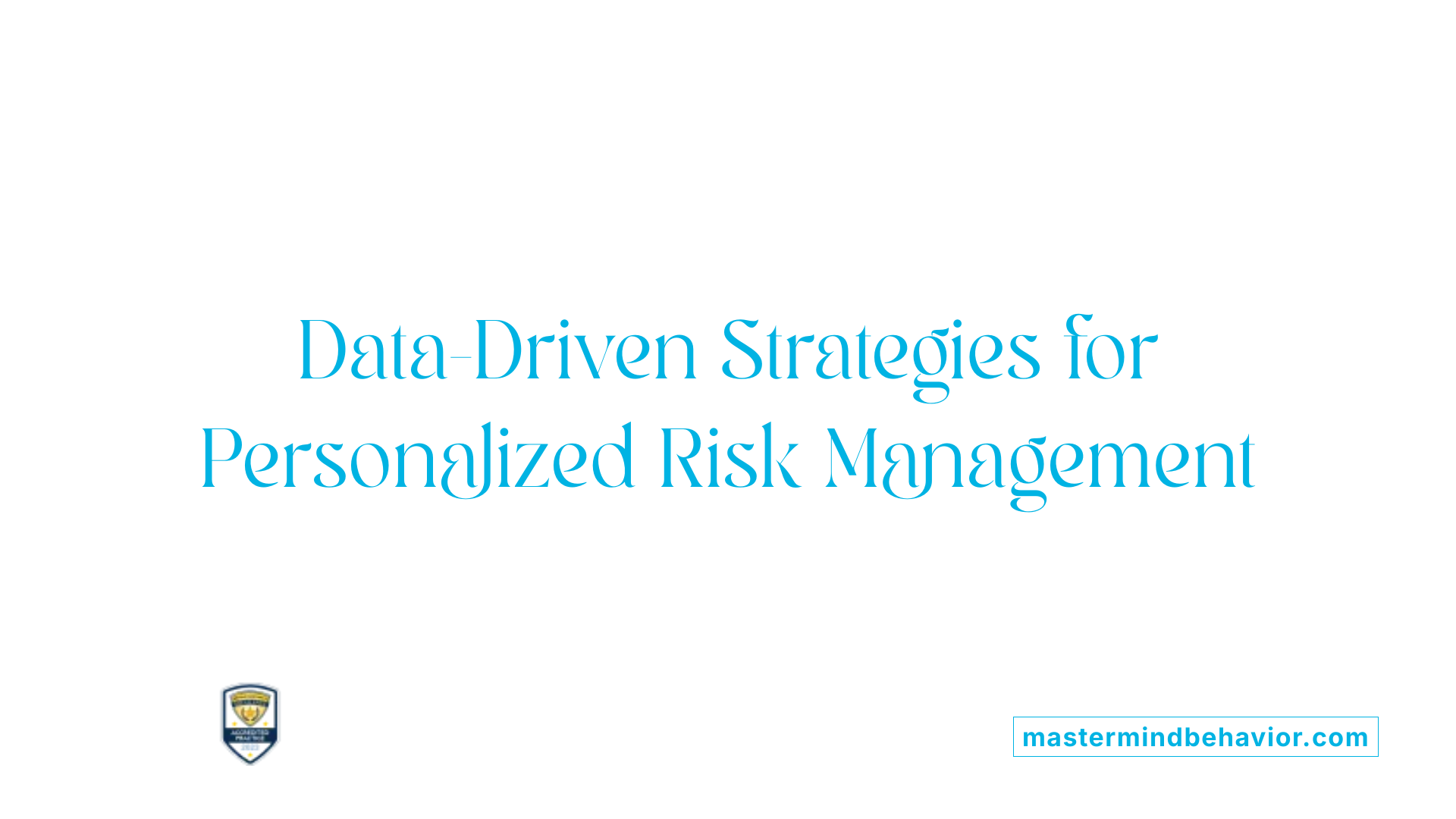
Data Collection and Measurement in ABA
Applied Behavior Analysis (ABA) relies heavily on systematic data collection to guide treatment decisions. Measurement involves continuous, objective recording of target behaviors and environmental variables. Assessment methods include direct observation, functional behavior assessments (FBA), standardized tests, and interviews. These tools help identify the function of problem behaviors and inform personalized intervention plans aligned with the individual’s needs.
Short-term and Long-term Outcome Evaluation
Effective ABA treatment includes monitoring both proximal (short-term) and distal (long-term) outcomes. Short-term measures track immediate changes in specific target behaviors while long-term measures observe broader skill acquisition and behavior maintenance over time. Validated and reliable tools ensure progress is accurately captured, supporting adjustments and highlighting areas requiring additional focus.
Adapting Interventions Based on Behavioral Progress
Ongoing data analyses permit treatment modifications as progress is made or challenges arise. For example, if extinction or differential reinforcement strategies do not yield expected reductions in problematic behavior, intensifying or shifting to complementary techniques like Functional Communication Training (FCT) may be warranted. This dynamic approach ensures treatment remains client-centered and responsive to evolving behavioral patterns.
Treatment Fidelity and Case Supervision
Maintaining treatment fidelity is critical for maximizing intervention efficacy. ABA providers, including Board Certified Behavior Analysts (BCBAs) and Registered Behavior Technicians (RBTs), engage in regular supervision and case reviews. Supervisors monitor data collection accuracy, intervention integrity, and client response. Adjustments to protocols are made based on comprehensive data review, ensuring consistency, adherence to best practices, and ethical standards.
This structured, data-driven framework allows ABA practitioners to tailor interventions effectively and manage behavioral risks comprehensively, ultimately improving outcomes for children with autism and related developmental challenges.
Ethical Considerations and Informed Consent in ABA Therapy for Risk Management
Why Is Informed Consent Important in ABA Therapy?
Informed consent is a cornerstone of ethical ABA practice, ensuring that families, caregivers, and individuals fully understand the nature, benefits, and potential risks of interventions. It fosters trust and partnership between providers and families, helping align therapy goals with individual needs and preferences.
How Can ABA Providers Effectively Communicate Risks?
Effective risk communication involves transparent discussions about treatment procedures, safety protocols, and any potential side effects. ABA providers use clear, accessible language and provide opportunities for questions to ensure families are well-informed. This is especially vital during times like the COVID-19 pandemic, where safety measures and regional risk data must be shared thoughtfully.
How Does ABA Respect Autonomy and Individual Preferences?
ABA embraces respect for the individual's autonomy by personalizing interventions based on preferences and needs. Modern ABA emphasizes positive reinforcement, naturalistic, and play-based methods rather than aversive techniques, supporting the dignity and neurodiversity of the individual.
How Are Ethical Guidelines and Evidence-Based Practices Integrated?
ABA therapy aligns closely with ethical standards by using scientifically validated procedures and continuous assessment to tailor treatment plans. Providers adhere to guidelines like those from the CDC for safety and sanitation, and regularly monitor treatment fidelity and outcomes to uphold best practices.
| Aspect | Description | Example |
|---|---|---|
| Informed Consent | Transparent, ongoing dialogue with families and individuals about treatment | Discussions before starting treatment and during adjustments |
| Risk Communication | Clear explanation of therapy risks and safety measures | Sharing COVID-19 risk screening and sanitation protocols |
| Respect for Autonomy | Individualized, preference-based interventions that honor neurodiversity | Use of play-based techniques and avoidance of aversive methods |
| Ethical Alignment | Evidence-based, scientifically validated and continuously monitored intervention planning | Using validated outcome measures and following CDC guidelines |
Integrative Approaches: Combining Behavioral and Pharmacological Treatments
Addressing complex behaviors with multi-disciplinary strategies
Complex cases of autism spectrum disorder (ASD) and intellectual disability (ID) often involve both environmental and biological factors influencing problem behavior. To effectively address these multifaceted issues, an integrative transdisciplinary approach is recommended. This strategy combines behavioral interventions like Applied Behavior Analysis (ABA) with pharmacological treatments to tailor plans that respond to the specific needs of each individual.
Role of behavioral assessment in medication planning
Functional Behavior Assessment (FBA) plays a crucial role beyond guiding behavioral interventions; it also informs psychiatric and pharmacologic treatment decisions. By identifying the environmental variables that control problem behaviors, clinicians can better understand underlying triggers and functions. This insight helps in selecting appropriate medications alongside behavioral strategies, leading to more nuanced and effective management of challenging behaviors.
Benefits of a transdisciplinary model for risk and behavioral management
A transdisciplinary model promotes collaboration among behavior analysts, medical professionals, families, and other stakeholders. This holistic coordination ensures that risk assessments—such as those tailored for ABA providers during the COVID-19 pandemic which include regional data and symptom screening—are integrated with individualized behavioral treatment. Such comprehensive oversight enhances ethical and safety considerations while enabling flexible service delivery options like telehealth or adjusted in-clinic procedures. Ultimately, blending behavioral and pharmacological treatments supports more personalized, effective, and safe interventions for children with ASD and ID.
Responding to COVID-19: Risk Assessment and Safety Protocols in ABA Service Delivery
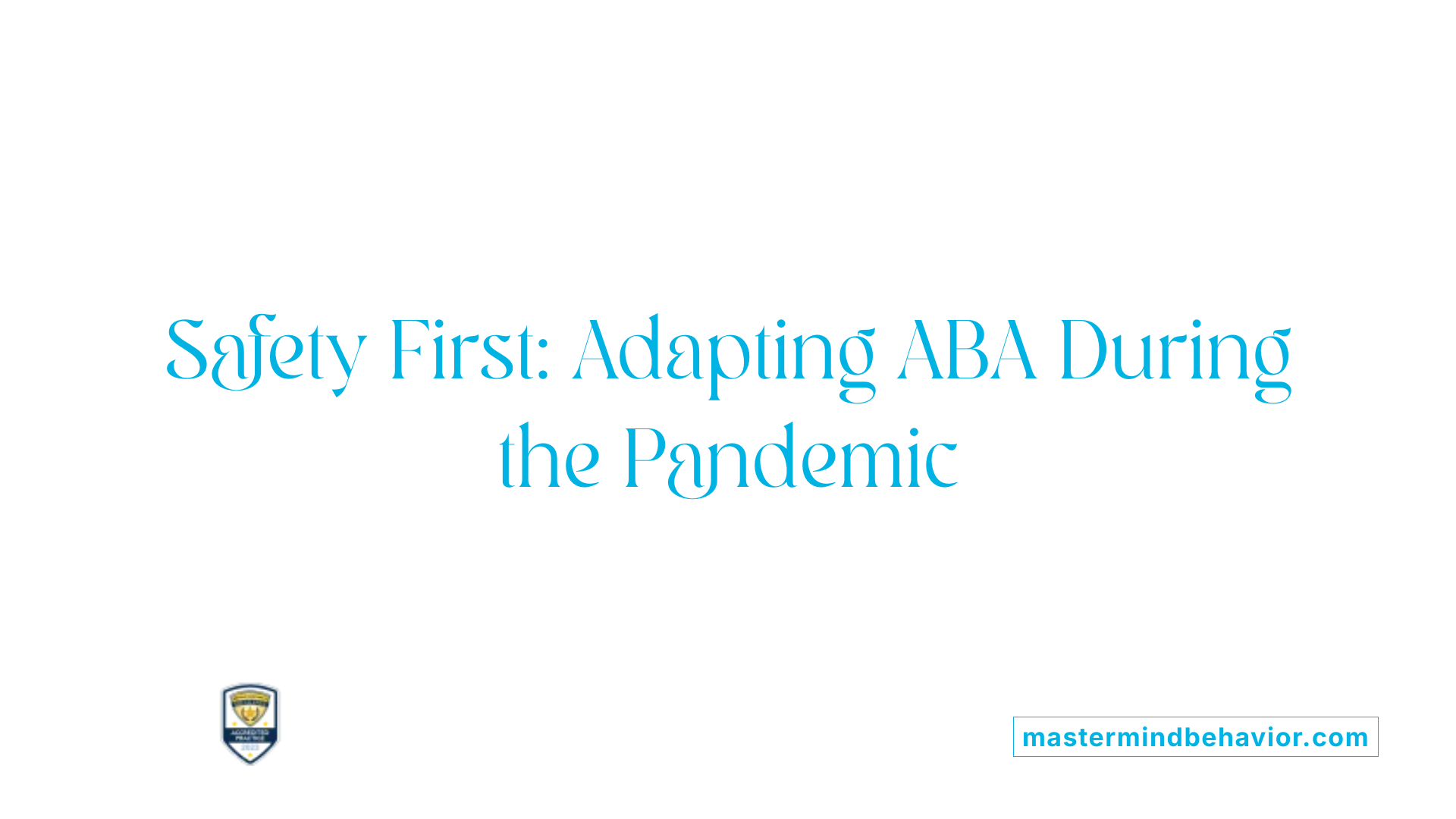
How are region-specific risk assessments and symptom screening implemented in ABA services?
ABA providers utilize detailed tools for risk assessment and mitigation tailored specifically for the COVID-19 pandemic. These include regional and individual risk assessments that rely heavily on up-to-date local data such as hospital capacity and infection rates, with Michigan’s case data serving as a key example. Symptom screening protocols are systematically applied to ensure safety before in-person sessions begin.
What sanitation and safety procedures aligned with CDC guidelines are followed?
Treatment settings incorporate rigorous sanitation measures consistent with CDC recommendations. This includes frequent cleaning of surfaces, availability of hand sanitation stations, and environmental modifications to reduce virus transmission. Such evidence-based procedures ensure that the therapeutic environment remains as safe as possible for children, families, and staff.
How have ABA services adapted their delivery modes during the pandemic?
Service delivery modifications have been essential for balancing safety and efficacy. ABA interventions have shifted toward flexible approaches, including telehealth platforms, which allow continuous therapy without physical contact. In-clinic services are adjusted according to regional safety phases, applying reduced hours, physical distancing, and personal protective equipment to minimize risks while maintaining treatment quality.
What ethical responsibilities do providers have towards families and staff during COVID-19?
ABA providers emphasize informed consent and transparent risk communication with families and staff. Sharing relevant information about safety measures, potential exposure risks, and procedural changes respects ethical standards and builds trust. This transparent approach ensures that decisions about treatment continuation are collaborative and grounded in current health data.
These comprehensive, adaptable strategies create a framework that balances the need for essential ABA services with the imperative to safeguard health during the pandemic.
Assessing the Impact of ABA Therapy on Intellectual and Adaptive Functioning
Meta-analysis findings on intellectual gains
A meta-analysis examining 11 studies with 632 participants assessed the effects of applied behavior analysis (ABA) on children with autism spectrum disorder (ASD). The findings revealed a medium effect size for intellectual functioning, with a standardized mean difference (SMD) of 0.51. This suggests that ABA-based interventions can lead to notable improvements in cognitive abilities among young children receiving treatment.
Effects on adaptive behavior
The same meta-analysis also evaluated the impact of ABA on adaptive behaviors, which include skills necessary for daily living. The results showed a small but positive effect (SMD=0.37), indicating that children engaged in ABA interventions tend to develop better adaptive functioning over time. This enhancement supports greater independence and improved quality of life for individuals with ASD.
Limitations regarding language and symptom severity changes
While ABA demonstrated benefits in intellectual and adaptive domains, the analysis did not find significant effects on language abilities, symptom severity related to autism, or parental stress levels when compared with control treatments. This highlights that although ABA positively influences some crucial developmental areas, its impact on communication skills and core ASD symptoms requires further investigation. Moreover, variability in study designs and participant characteristics, such as age and comorbidities, may influence these outcomes, emphasizing the need for more rigorous and diverse research.
Factors Influencing Outcomes: Treatment Intensity, Age, and Initial Ability

Moderating Effects of Treatment Dose and Child Age
Treatment intensity, typically measured in hours per week, plays a significant role in the effectiveness of applied behavior analysis (ABA) for children with autism spectrum disorder (ASD). Early intensive behavioral interventions, ranging from 20 to 40 hours weekly, are associated with improved intellectual and adaptive functioning outcomes. However, research shows that treatment impact tends to decrease as children get older. Interventions initiated at younger ages, notably between 2 and 5 years, often yield better developmental gains compared to those started later. This suggests that early intervention is critical for maximizing the benefits of ABA therapy.
Influence of Baseline Language Abilities
Baseline language abilities at the start of treatment also influence ABA therapy outcomes. Children with higher initial language skills generally demonstrate greater progress through intervention. This relationship underscores the importance of assessing individual communication profiles prior to designing treatment plans. By understanding a child's starting communicative capacities, providers can better tailor functional communication training (FCT) and other communication-focused strategies to enhance learning and reduce problem behaviors effectively.
Need for Tailored Interventions Based on Individual Profiles
Given the variability in child age, treatment dose, and initial abilities, ABA interventions must be personalized. Treatment plans should incorporate comprehensive assessments, including functional behavioral assessments (FBAs) and skills-based evaluations, to identify specific strengths and challenges. Personalized approaches ensure that therapy goals align with individual needs and promote meaningful skill acquisition. Integrating treatment intensity, age considerations, and baseline competencies allows providers to optimize intervention effectiveness and support long-term development.
Table: Factors Influencing ABA Treatment Outcomes
| Factor | Influence on Outcome | Clinical Implication |
|---|---|---|
| Treatment Intensity | Higher doses (>20 hrs/week) linked to better outcomes | Prioritize early, intensive interventions where possible |
| Child Age | Earlier treatment start improves effectiveness | Initiate ABA therapy as soon as possible for best results |
| Baseline Language Ability | Higher initial language skills predict greater gains | Assess and target language skills to customize strategies |
ABA Therapy and Neurodiversity: Respecting Individuality While Encouraging Growth
Balancing skill acquisition with acceptance of autistic traits
Applied behavior analysis (ABA) therapy focuses on developing meaningful skills and reducing harmful behaviors in children with autism. Importantly, modern ABA prioritizes building independence and functional abilities without aiming to erase inherent autistic traits. The approach respects neurodiversity by concentrating on improving quality of life and expanding choices rather than attempting to make individuals appear neurotypical.
Avoiding harmful attempts to mask neurodiversity
Some criticisms have been raised regarding earlier ABA approaches that emphasized suppressing behaviors like stimming, which autistic individuals use to self-regulate. Masking or forcing conformity can cause emotional distress and a loss of authentic self-identity. While original ABA methods included aversive techniques no longer in use, current ethical guidelines stress the avoidance of punishment and the minimization of interventions that could harm the individual’s well-being. Practitioners recognize the importance of supporting autistic children positively, to prevent burnout and trauma.
Play-based, less repetitive modern ABA approaches
Modern ABA therapies have evolved to be more engaging and individualized, using play-based and naturalistic methods rather than repetitive drills. This allows children to learn in a way that feels more enjoyable and less demanding, supporting intrinsic motivation and better generalization of skills. Techniques such as Early Intensive Behavioral Interventions (EIBI) and naturalistic developmental behavioral interventions (NDBI) exemplify this shift. The goal is to foster growth in a manner that honors each child’s unique personality and respects their neurodiversity.
Challenges and criticisms associated with ABA therapy in autism treatment
ABA therapy faces challenges related to concerns it may focus excessively on eliminating behaviors that serve important coping functions, like stimming. Critics highlight risks that some implementations pressure children to mask their neurodiversity, negatively impacting mental health and identity. Despite improvements over decades, ethical questions remain about intensity and appropriateness, especially if treatments are not tailored sensitively. Ongoing debates underscore the necessity for ABA to be respectful, individualized, and attuned to the needs of autistic people, supporting wellbeing above conformity.
Building Safety Through Positive Reinforcement and Risk Mitigation Strategies

Applying extinction and differential reinforcement to reduce risky behaviors
Applied Behavior Analysis (ABA) employs several effective strategies to decrease risky behaviors in children with autism spectrum disorder (ASD). Extinction involves withholding reinforcement for problem behaviors, leading to a gradual decrease in those behaviors. Differential reinforcement strengthens alternative, safer behaviors by reinforcing them while withholding reinforcement for the unwanted ones. These behavioral interventions are based on understanding the function of the problem behavior and have robust empirical support.
Teaching replacement behaviors through functional communication
Functional Communication Training (FCT) is a highly effective ABA-based method that teaches individuals to use appropriate communication as a replacement for problematic behaviors. For example, a child might learn to request assistance or express discomfort instead of engaging in self-injury or aggression. Studies indicate that FCT can lead to over 80% reduction in problem behaviors by providing a clear, communicative alternative that meets the same needs previously addressed by the risky behavior.
Encouraging safe exploration through rewards
Positive reinforcement is central to ABA’s approach in promoting safe and adaptive behaviors. By rewarding safe exploration and appropriate interactions with the environment, children are encouraged to build new skills and confidence. Modern ABA interventions utilize play-based and naturalistic methods, which reduce repetition and increase engagement, promoting meaningful learning experiences that foster independence while respecting each child's unique neurodiversity.
Together, these strategies form a comprehensive approach to risk mitigation and behavior improvement that supports children's safety and development in engaging, respectful ways.
Supporting Families: Parental Involvement and Stress Management in ABA
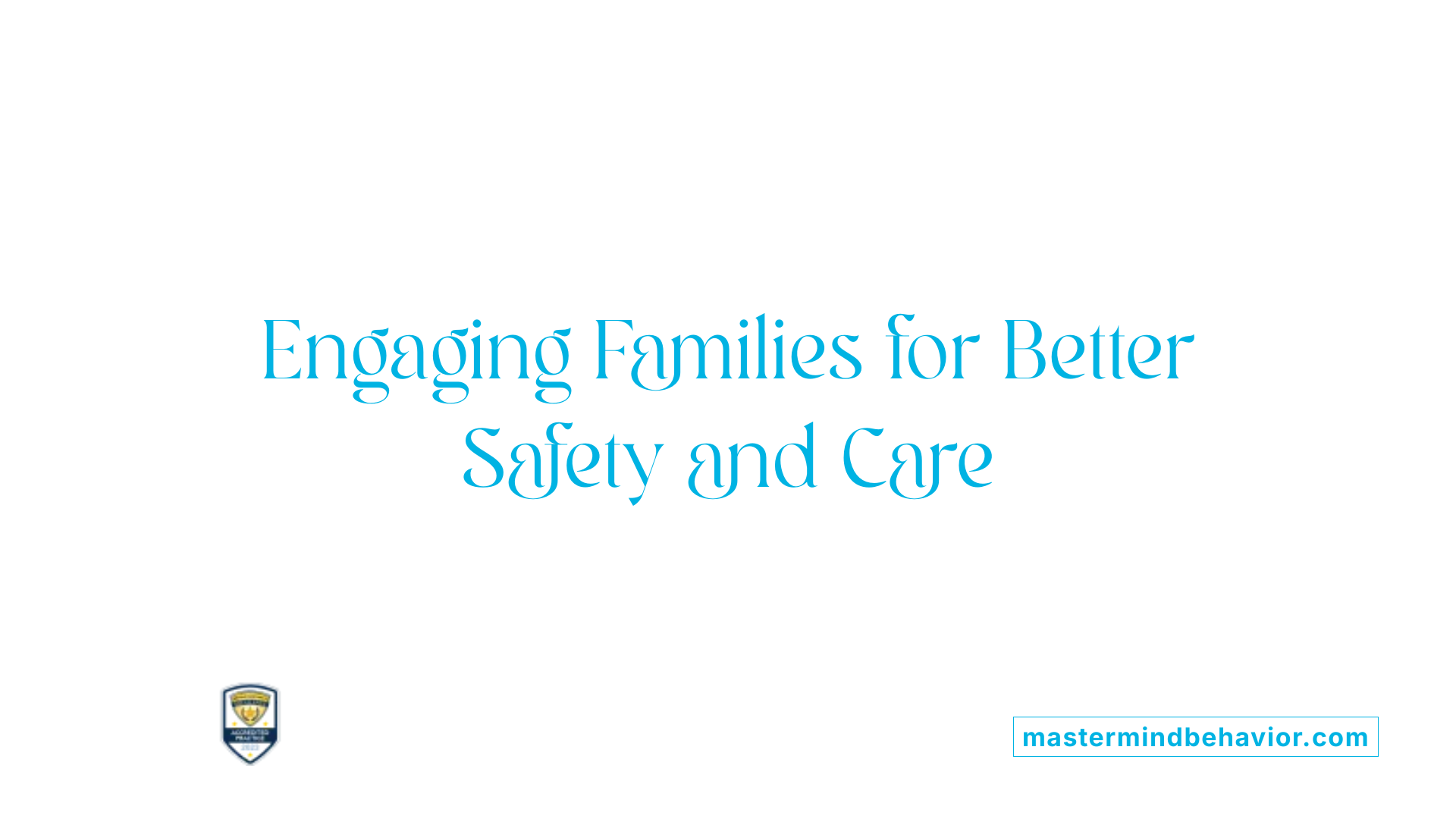
Family participation in treatment planning
Parental involvement is a cornerstone of effective Applied Behavior Analysis (ABA) therapy. Treatment plans are individualized and incorporate caregiver input to ensure goals align with the needs and preferences of the child and family. Providers use assessment practices such as interviews and direct observation to gather family perspectives, which helps in designing interventions that fit the home environment. Additionally, ongoing communication enables families to actively participate in monitoring progress and adapting strategies.
Addressing parental stress through evidence-based interventions
Research has shown that ABA-based interventions can impact parental stress, although meta-analyses indicate no significant reductions in stress beyond control treatments. Despite this, engaging families as partners and providing clear guidance about goals and progress can alleviate anxiety related to their child’s behavior. Tailored support, psychoeducation, and opportunities for parents to learn functional communication training (FCT) techniques bolster caregivers’ confidence in managing difficult behaviors at home.
Communication strategies to empower caregivers
Effective communication between providers and families fosters transparency and informed consent, especially important during challenges like the COVID-19 pandemic. ABA professionals emphasize risk communication and involve families in safety planning and decision-making. Clear, consistent updates about treatment modifications, such as telehealth options and sanitation protocols, empower caregivers to feel confident and safe. This two-way dialogue strengthens family-provider partnerships, enhancing treatment adherence and child outcomes.
Tiered Service Delivery Models: Efficiency and Quality in ABA Treatment
What are Two-tiered and Three-tiered Supervision Structures?
Tiered service delivery models in Applied Behavior Analysis (ABA) organize treatment supervision to enhance efficiency while maintaining high-quality care. In two-tiered models, Board Certified Behavior Analysts (BCBAs) directly oversee Registered Behavior Technicians (RBTs) delivering intervention. Three-tiered models add an intermediate level by involving Board Certified Assistant Behavior Analysts (BCaBAs) who support BCBAs by supervising RBTs, allowing for more distributed oversight.
How Does Role Delegation Work Among BCBAs, BCaBAs, and RBTs?
In these tiered frameworks, BCBAs are responsible for designing individualized treatment plans, conducting assessments, and monitoring overall program outcomes. BCaBAs provide day-to-day supervision of RBTs and assist in data collection and behavior analysis under BCBA guidance. RBTs implement the actual interventions and work directly with clients, delivering hands-on support tailored to the client's needs. This delegation optimizes resource allocation by allowing highly trained analysts to focus on complex clinical decisions, while trained technicians manage routine implementation.
How is Treatment Fidelity Ensured in Complex Service Models?
Maintaining treatment fidelity is critical when multiple professionals are involved. Regular case supervision by BCBAs includes monitoring intervention integrity, reviewing treatment data, and conducting ongoing training for BCaBAs and RBTs. Frequent communication and standardized protocols help align the team’s approaches. Adjustments to treatment plans are data-driven and informed by continuous assessment, ensuring that every level of the service delivery chain reliably contributes to positive client outcomes.
These tiered models balance workload and expertise, helping ABA providers to deliver personalized care efficiently without compromising treatment quality.
ABA Therapy’s Role in Safety for Challenging Behaviors like Self-Injury
Identification and reduction of harmful behaviors
Applied Behavior Analysis (ABA) is a well-established, evidence-based treatment for addressing challenging behaviors in children with Autism Spectrum Disorder (ASD), including harmful behaviors such as self-injury. ABA focuses on analyzing and modifying environmental factors that influence behavior to produce meaningful and positive changes. By using scientifically validated procedures individualized to each child’s needs, ABA helps reduce behaviors that pose safety risks while teaching new, adaptive skills.
Utilizing functional behavior assessment for targeted interventions
A crucial step in safely managing problem behaviors is conducting a Functional Behavior Assessment (FBA). This client-driven method identifies the environmental variables controlling challenging behaviors like self-injury. Understanding the function of the behavior allows ABA therapists to design targeted interventions, such as extinction, non-contingent reinforcement (NCR), differential reinforcement, and functional communication training (FCT), that address the underlying causes rather than just symptoms.
Developing alternative communication and coping skills
One highly effective approach within ABA is Functional Communication Training (FCT), which replaces harmful behaviors with appropriate communication strategies. For example, children may learn to use words, gestures, or communication devices to express needs or frustrations instead of engaging in self-injury. Studies show reductions of over 80% in problem behaviors when FCT is applied, demonstrating significant improvements in both safety and quality of life.
Modern ABA methods are often naturalistic and play-based, enhancing engagement while respecting each child's neurodiversity. The goal is not to eliminate autistic traits but to build independence, improve safety, and enable greater participation in society. Ongoing assessment and supervision ensure treatment fidelity and adapt strategies to evolving needs, continually prioritizing safety and positive, functional outcomes.
Assessing and Improving Adaptive Behavior Through ABA Skills Training

Adaptive skills as targets for intervention
Applied Behavior Analysis (ABA) often focuses on enhancing adaptive behavior—the practical, everyday skills needed for personal and social sufficiency. These skills might include communication, self-care, social interaction, and functional routines that help individuals with autism participate more fully in daily life. Interventions prioritize building these skills through individualized, naturalistic methods like Naturalistic Developmental Behavioral Interventions (NDBI) and Early Start Denver Model (ESDM), which tailor learning opportunities to the child's environment and interests.
Measuring improvements in everyday functioning
Progress in adaptive behavior is systematically measured using validated and reliable assessment tools aligned with treatment goals. Many ABA studies show a modest yet meaningful increase in adaptive functioning after therapy, with a meta-analysis reporting a small effect size (standardized mean difference of 0.37). These measurements capture improvements in how children manage routines, communicate needs effectively, and engage socially, which are essential markers of quality of life.
Long-term life outcomes for individuals with autism
Although gains in adaptive behaviors are generally small to moderate, they can profoundly impact long-term independence and societal participation for individuals with autism. Early intensive ABA interventions, ideally started between ages 2 and 5, show potential for enhanced intellectual functioning and adaptive skills, contributing to better outcomes in education, employment, and social relationships later in life. The focus remains on equipping individuals with tools to increase choices, autonomy, and joy rather than attempting to mask neurodiversity.
| Topic | Description | Relevant Details |
|---|---|---|
| Adaptive Skills Targets | Functional routines and communication, promoting everyday independence | Personalized, play-based methods like NDBI and ESDM |
| Measuring Improvements | Use of standardized, reliable tools showing small effect size gains in adaptive behavior | Improvements correlated with treatment intensity and age at intake |
| Long-term Outcomes | Enhanced autonomy and participation in society through skill gains | Early treatment linked to better intellectual and adaptive outcomes |
Service Setting Considerations: Home, Clinic, and Community
Flexibility in Treatment Environments
Applied Behaviour Analysis (ABA) therapy is delivered in various settings based on the individual needs of the child, including home, clinic, and community environments. This flexibility allows treatment to be more personalized and responsive to the child’s daily life and challenges. Modifications in service delivery, such as telehealth or in-clinic adjustments, are often guided by regional safety conditions and phases, especially emphasized during the COVID-19 pandemic to ensure the safety of both clients and providers.
Generalization of Risk Assessment Skills Across Settings
Risk assessments are crucial tools within ABA therapy, tailored for diverse service settings. These assessments include regional and individual risk factors, symptom screening, and sanitation measures that follow CDC recommendations. Using region-specific data, like hospital and case data from local areas, helps guide safety protocols in homes, clinics, and community settings. Importantly, implementing consistent risk mitigation strategies across multiple settings supports safer, more effective intervention delivery.
Tailoring Intensity and Methods to Context
ABA interventions vary in intensity and methods depending on the treatment environment. For example, comprehensive interventions starting early in childhood often involve high-intensity schedules (20–40 hours per week) that may be best suited to clinic or home settings with structured support. Conversely, problem-focused interventions with narrower goals may be shorter and more adaptable to community settings. Additionally, naturalistic, play-based approaches facilitate engagement across different contexts, promoting skill generalization and functional communication training wherever the child interacts.
These service setting considerations ensure that ABA therapy remains a highly individualized, flexible approach. They emphasize safety, consistency, and the practical application of skills across environments to support long-term meaningful behavioral improvements in children with autism spectrum disorder.
Overcoming Methodological Challenges in ABA Research for Autism
Why is rigorous study design important in ABA research?
Rigorous study designs are crucial to accurately evaluate the effectiveness of ABA interventions in children with autism spectrum disorder (ASD). Strong methodologies, such as randomized controlled trials and well-controlled single-case designs, reduce potential biases and increase confidence in findings. However, many primary ABA studies currently suffer from limitations like low methodological quality and uncontrolled designs, which affect the reproducibility and generalizability of results.
How are biases and participant variability affecting ABA research?
Biases can arise due to the selection of participants, often focusing on young children without comorbidities predominantly from Western countries. This narrow sampling can limit the applicability of results to more diverse populations. Additionally, variations in treatment intensity, child age, and baseline language skills contribute to inconsistent outcomes. For instance, higher language abilities at intake often correlate with better progress, and treatment effectiveness tends to decline with increasing age.
What future research directions could enhance ABA effectiveness?
To refine ABA therapy, future research must emphasize:
- Increasing methodological rigor with well-designed, controlled trials.
- Including participants with a broader range of ages and comorbid conditions to better represent the ASD population.
- Exploring treatment moderators such as intensity, age, and individual differences in language and adaptive functioning.
- Investigating long-term outcomes beyond immediate gains, such as adaptive behavior and quality of life.
Addressing these challenges will help optimize ABA interventions, ultimately improving personalized treatment plans for children with autism.
| Research Challenge | Impact on ABA Findings | Proposed Solution |
|---|---|---|
| Low methodological quality | Limits reliability and replicability of results | Conduct well-controlled randomized trials and standardized protocols |
| Participant variability | Results may not generalize to all with ASD | Include diverse samples across age, severity, and comorbidities |
| Bias in study selection | Overrepresentation of certain demographics | Broaden recruitment to diverse populations |
| Treatment heterogeneity | Inconsistent outcome measures and effectiveness | Standardize intervention components and outcome assessments |
ABA Therapy’s Historical Evolution: From Aversive to Supportive Practices
Early Use of Punishment and Aversive Methods
Applied Behavior Analysis (ABA) therapy originally included practices such as Discrete Trial Training (DTT) that sometimes used aversive methods, including electric shocks, to reduce problem behaviors. These early interventions focused heavily on behavioral compliance and could be quite demanding for the children receiving treatment.
Shift to Ethical, Play-Based, and Individualized Interventions
Today, the field of ABA has undergone a significant ethical transformation. Aversive methods are now widely considered unacceptable and have been abandoned. Modern ABA approaches emphasize less demanding, individualized strategies that prioritize the child’s comfort and engagement. Interventions are often naturalistic and play-based, involving fewer repetitions and more interactive activities designed to foster learning in enjoyable ways.
Current Best Practices and Professional Standards
Current best practices focus on respecting each child’s neurodiversity while promoting skill-building and independence. ABA therapy is delivered by qualified professionals such as Board Certified Behavior Analysts (BCBAs) and Registered Behavior Technicians (RBTs), ensuring treatment is individualized and rooted in scientific validation. Treatment plans incorporate ongoing assessment, caregiver input, and use positive reinforcement to encourage new skills while reducing harmful behaviors. The goal is to help children with autism participate more fully in society, expanding their choices and joy without attempting to alter their inherent neurodiverse identity.
Safety Protocols and Ethical Guidelines During Public Health Crises
How is risk mitigated during the COVID-19 pandemic for ABA services?
ABA providers have implemented comprehensive risk mitigation strategies tailored specifically to the challenges posed by the COVID-19 pandemic. These include detailed tools for risk assessment and mitigation such as regional and individual risk evaluations, symptom screenings, sanitation protocols aligned with CDC recommendations, and the use of symptom screening to protect clients and staff.
Region-specific data, including local hospital and case statistics such as those from Michigan, inform decisions about which services can safely continue. Scientific evidence indicating that children contribute minimally to COVID-19 transmission supports the continuation of in-person ABA services when proper precautions are taken.
How are interventions adapted to maintain health safety without compromising treatment quality?
Treatment delivery models have been modified flexibly according to regional safety phases to ensure both continuous care and health protection. These modifications include shifting between telehealth services and in-clinic adjustments. Telehealth enables families to access ABA interventions while reducing physical contact risks, whereas in-clinic services operate with enhanced sanitation procedures and social distancing when local data permit.
This adaptive approach ensures that the quality and individualization central to ABA—such as personalized treatment goals and ongoing assessment—are preserved even in the context of a public health crisis.
What are the ethical responsibilities of ABA providers to clients and staff during public health emergencies?
ABA providers uphold important ethical responsibilities involving informed consent and transparent communication about risks. Providers must engage families and staff in discussions about safety measures and potential risks related to COVID-19 exposure to respect client autonomy and ensure trust.
Ethical practice also includes protecting client and staff well-being through adherence to established public health guidelines, promoting evidence-based safety protocols, and maintaining treatment fidelity while adapting service delivery models. Maintaining transparency and prioritizing safety reflects the ABA community’s commitment to ethical and client-centered care during pandemics and other emergencies.
Measuring Treatment Outcomes to Ensure Meaningful Skill Development

Use of Validated Assessment Tools
ABA treatment emphasizes the use of validated, reliable assessment tools to measure progress. These tools include standardized tests, direct observations, skill-based assessments, and functional behavior assessments. By employing scientifically recognized methods, ABA providers ensure that treatment outcomes accurately reflect meaningful changes in behavior and skill acquisition.
Monitoring Proximal and Distal Goals
Treatment goals in ABA are structured around both proximal (short-term) and distal (long-term) objectives. Proximal goals focus on immediate skill development or behavior changes that set the foundation for broader achievements. Distal goals aim at sustained independence and functional improvements over time. Monitoring both enables providers to evaluate progress comprehensively and ensure interventions remain aligned with the child's evolving needs.
Adjusting Strategies Based on Outcome Data
Ongoing data collection and analysis allow ABA practitioners to adapt treatment plans dynamically. Case supervision involves reviewing treatment fidelity and outcome data to identify if current strategies effectively promote skill development or require modification. Adjustments may include changing intervention intensity, introducing new teaching methods, or refocusing goals to better fit the child's growth trajectory.
Through this rigorous and responsive approach to outcome measurement, ABA ensures meaningful skill development that respects individual needs and promotes lasting positive changes in children with autism spectrum disorder.
The Importance of Family and Community Engagement to Reinforce Risk Assessment Skills

Collaborative goal setting with caregivers
Successful ABA interventions prioritize collaboration with families to ensure that treatment goals align with the child's needs and the family's values. Behavior analysts assess each child's specific risks and behaviors and incorporate family input to tailor interventions effectively. This process enhances caregivers' understanding of risk factors and promotes consistency in applying safety strategies at home and in community settings.
Training families in risk awareness techniques
ABA providers emphasize educating families on environment-based factors influencing problem behaviors through functional behavior assessments (FBA). Caregivers are trained in identifying early warning signs and implementing proactive measures such as extinction, non-contingent reinforcement (NCR), and functional communication training (FCT). This hands-on training empowers families to reduce problem behaviors safely and reinforces learning beyond clinical environments.
Building community supports for safety and inclusion
Community involvement magnifies the impact of ABA treatments by fostering safer and more inclusive environments for children with autism. Outreach initiatives encourage collaboration among schools, healthcare providers, and local organizations to maintain consistent risk mitigation strategies. During the COVID-19 pandemic, region-specific data and safety protocols guide in-person services, ensuring that community supports remain adaptive yet protective. Ethical considerations such as informed consent and ongoing risk communication between providers, families, and staff underpin these collaborative efforts, reinforcing a united approach to child safety and well-being.
Future Directions: Expanding Research and Practice to Enhance Risk Assessment Skills

Need for High-Quality Randomized Controlled Trials
Advancing the evidence base for Applied Behavior Analysis (ABA) requires more rigorous research designs. Currently, much of the existing literature includes studies with low methodological quality or uncontrolled designs. Increasing the number of well-conducted randomized controlled trials (RCTs) will help clarify ABA’s true effect sizes and better validate interventions, particularly those focusing on risk assessment and management strategies. This level of research rigor is essential for strengthening clinical recommendations and guiding best practices in ABA treatments.
Exploring Moderators of Treatment Success
Understanding the factors that influence ABA treatment outcomes is crucial for optimizing intervention effectiveness. Variables such as child age, treatment intensity, initial language abilities, and the presence of comorbidities have been identified as potential moderators. Future research should systematically investigate these factors, especially their interaction with risk assessment skills development. Such information will enable personalized treatment planning, helping practitioners tailor interventions to individual needs and environmental contexts.
Incorporation of Technology and Telehealth for Skill Development
The recent COVID-19 pandemic has accelerated the integration of telehealth and technology-enhanced service delivery within ABA. Future directions include expanding the use of virtual platforms and digital tools to support skill acquisition in risk assessment and mitigation. Telehealth allows for flexible, region-specific service adjustments and continued care despite public health challenges. Moreover, technology can provide innovative methods for remote monitoring, real-time data collection, and interactive training modules that enhance practitioner and client competency in managing behavioral risks effectively.
Fostering Safe, Independent Living Through ABA-Informed Risk Skills
Applied Behavior Analysis therapy is a transformative approach that goes beyond managing autism's core challenges to actively cultivate critical life skills such as healthy risk assessment. Through individualized, data-driven strategies and ethically grounded interventions, ABA empowers individuals with autism to make safer choices, communicate needs effectively, and build independence across their lifespan. As the field evolves with rigorous research and compassionate practice, ABA continues to offer a path for greater autonomy and quality of life — helping individuals with autism navigate their world with confidence and care.
References
- Treatment of severe problem behaviour in children with ...
- Risk Assessment and Mitigation Strategies for Applied ...
- Comprehensive ABA-based interventions in the treatment of ...
- Applied Behavior Analysis Practice Guidelines for the ...
- The Controversy Around ABA
- Applied Behavior Analysis (ABA)
- How to Become an ABA Therapist - School of Education
Recent articles

The Role of Parent Priorities in Designing ABA Goals
Collaborative Goal-Setting: Aligning ABA Therapy with Family Priorities

Translating ABA Goals into Everyday Functional Skills
Bridging Theory and Practice: How ABA Therapy Enhances Daily Life for Individuals with Autism

How To Integrate ABA Strategies During Mealtime And Snack Time
Practical ABA Techniques to Enhance Mealtime Experiences for Children with Autism

ABA Therapy To Support Emotional Expression In Young Children
Harnessing ABA Therapy to Enhance Emotional Expression in Early Childhood Autism

Understanding Functional Communication Training (FCT) In ABA Therapy
Unlocking Communication: How Functional Communication Training Transforms ABA Therapy

ABA Therapy To Reduce Argumentative Behavior In Children
Transforming Challenging Behaviors: The Role of ABA in Autism Care



